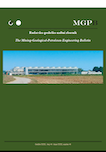Evaluation of the spontaneous combustion of coal (SCC) by using the R70 test method based on the correlation among intrinsic coal properties (Case study: Tabas Parvadeh coal mines, Iran)
DOI:
https://doi.org/10.17794/rgn.2019.3.6Keywords:
sustainable development, spontaneous combustion of coal (SCC), Tabas Parvadeh coal mines, intrinsic coal properties, R70 test methodAbstract
The purpose of this research is to perform an evaluation of the spontaneous combustion of coal (SCC) in Tabas Parvadeh coal mines in Iran, by using the R70 test method based on a the correlation between intrinsic coal properties and the occurrence of its combustion. Firstly, the coal samples were collected from Parvadeh I to IV, and the intrinsic coal properties of the samples were tested. Then, the R70 test method, as the newest method for assessment of the SCC, was used. In the last step, the correlation between intrinsic coal properties and R70 test values was carried out. The results showed that the B1 seam in Parvadeh II and the C1 seam in Parvadeh III have a high propensity of the SCC. The outcomes appear, an expansion of moisture, pyrite,vitrinite,and liptinitecontents enhance the SCC tendency in these mines. The results obtained have major outcomes for the management of this phenomenon in Tabas Parvadeh coal mines.
Downloads
Published
How to Cite
Issue
Section
License
Copyright (c) 2019 authors and journal

This work is licensed under a Creative Commons Attribution 4.0 International License.
Creative Commons-BY
Authors who publish with this journal agree to the following terms:
In agreeing this form, you certify that:
- You read the ethical codex of the RGN zbornik available at journal web.
- You submitted work is your original work, and has not previously been published and does not include any form of plagiarism.
- You own copyright in the submitted work, and are therefore permitted to assign the licence to publish to RGN zbornik.
- Your submitted work contains no violation of any existing copyright or other third party right or any material of an obscene, libellous or otherwise unlawful nature.
- You have obtained permission for and acknowledged the source of any illustrations, diagrams or other material included in the work of which you are not the copyright owner.
- You have taken due care to ensure the accuracy of the work, and that, to the best of your knowledge, there are no false statements made within it.
- All co-authors of this submitted work are aware of, and in agreement with, the terms of this licence and that the submitted manuscript has been approved by these authors.
Publication licence
You retain copyright in your submitted work, according to journal license policy (CC-BY). By signing this form you agree that RGN zbornik may publish it under the publication licence. In summary the licence allows the following:
Anyone is free:
- To copy, distribute, display, and perform the work.
- To make derivative works.
Under the following conditions:
- The original author must always be given credit.
- The work may not be used for commercial purposes.
- If the work is altered, transformed, or built upon, the resulting work may only be distributed under a licence identical to this one.
Exceptions to the licence
In addition to publishing the work printed under the above licence, RGN zbornik will also enable the work to be visible online.
The journal editorial can change the licence rules anytime but it cannot retroactively restrict author(s) rights.


